No. 19. Agriculture, Pasture and Mixed Environs
W. Daniel Edge, Rex C. Crawford, and David H. Johnson
Geographic Distribution. Agricultural habitat is widely distributed at
low to mid-elevations (<6,000 ft [1,830 m]) throughout both states. This
habitat is most abundant in broad river valleys throughout both states and on
gentle rolling terrain east of the Cascades.
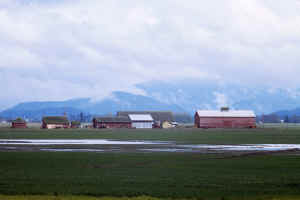 Physical Setting. This habitat is maintained across a range of climatic
conditions typical of both states. Climate constrains agricultural production at
upper elevations where there are <90 frost-free days. Agricultural habitat in
arid regions east of the Cascades with <10 inches (25 cm) of rainfall require
supplemental irrigation or fallow fields for 1-2 years to accumulate sufficient
soil moisture. Soils types are variable, but usually have a well developed A
horizon. This habitat is found from 0 to 6,000 ft (0 to 1,830 m) elevation. Physical Setting. This habitat is maintained across a range of climatic
conditions typical of both states. Climate constrains agricultural production at
upper elevations where there are <90 frost-free days. Agricultural habitat in
arid regions east of the Cascades with <10 inches (25 cm) of rainfall require
supplemental irrigation or fallow fields for 1-2 years to accumulate sufficient
soil moisture. Soils types are variable, but usually have a well developed A
horizon. This habitat is found from 0 to 6,000 ft (0 to 1,830 m) elevation.
Landscape Setting. Agricultural habitat occurs within a matrix of other
habitat types at low to mid-elevations, including Eastside grasslands,
Shrub-steppe, Westside Lowlands Conifer-Deciduous Forest and other low to
mid-elevation forest and woodland habitats. This habitat often dominates the
landscape in flat or gently rolling terrain, on well-developed soils, broad
river valleys, and areas with access to abundant irrigation water. Unlike other
habitat types, agricultural habitat is often characterized by regular landscape
patterns (squares, rectangles, and circles) and straight borders because of
ownership boundaries and multiple crops within a region. Edges can be abrupt
along the habitat borders within agricultural habitat and with other adjacent
habitats.
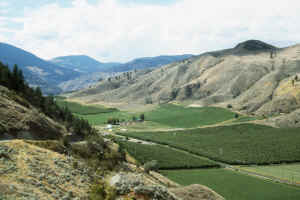 Structure. This habitat is structurally diverse because it includes
several cover types ranging from low-stature annual grasses and row crops
(<3.3 ft [1 m]) to mature orchards (>66 ft [20 m]). However, within any
cover type, structural diversity is typically low because usually only 1 to a
few species of similar height are cultivated. Depending on management intensity
or cultivation method, agricultural habitat may vary substantially in structure
annually; cultivated cropland and modified grasslands are typified by periods of
bare soil and harvest whereas pastures are mowed, hayed, or grazed 1 or more
times during the growing season. Structural diversity of agricultural habitat is
increased at local scales by the presences of non-cultivated or less intensively
managed vegetation such as fencerows, roadsides, field borders, and
shelterbelts. Structure. This habitat is structurally diverse because it includes
several cover types ranging from low-stature annual grasses and row crops
(<3.3 ft [1 m]) to mature orchards (>66 ft [20 m]). However, within any
cover type, structural diversity is typically low because usually only 1 to a
few species of similar height are cultivated. Depending on management intensity
or cultivation method, agricultural habitat may vary substantially in structure
annually; cultivated cropland and modified grasslands are typified by periods of
bare soil and harvest whereas pastures are mowed, hayed, or grazed 1 or more
times during the growing season. Structural diversity of agricultural habitat is
increased at local scales by the presences of non-cultivated or less intensively
managed vegetation such as fencerows, roadsides, field borders, and
shelterbelts.
Composition. Agricultural habitat varies substantially in composition
among the cover types it includes. Cultivated cropland includes >50 species
of annual and perennial plants in Oregon and Washington, and hundreds of
varieties ranging from vegetables such as carrots, onions, and peas to annual
grains such as wheat, oats, barley, and rye. Row crops of vegetables and herbs
are characterized by bare soil, plants, and plant debris along bottomland areas
of streams and rivers and areas having sufficient water for irrigation. Annual
grains, such as barley, oats, and wheat are typically produced in almost
continuous stands of vegetation on upland and rolling hill terrain without
irrigation.
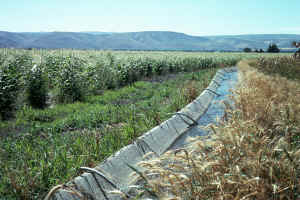 The orchard/vineyard/nursery cover type is composed of fruit and nut (apples,
peaches, pears, and hazelnuts) trees, vineyards (grapes, Kiwi), berries
(strawberries, blueberries, blackberries, and raspberries), Christmas trees, and
nursery operations (ornamental container and greenhouses). This cover type is
generally located on upland sites with access to abundant irrigation.
Cultivation for most orchards, vineyards and Christmas tree farms includes an
undergrowth of short-stature perennial grasses between the rows of trees, vines,
or bushes. Christmas trees are typically produced without irrigation on upland
sites with poorer soils. The orchard/vineyard/nursery cover type is composed of fruit and nut (apples,
peaches, pears, and hazelnuts) trees, vineyards (grapes, Kiwi), berries
(strawberries, blueberries, blackberries, and raspberries), Christmas trees, and
nursery operations (ornamental container and greenhouses). This cover type is
generally located on upland sites with access to abundant irrigation.
Cultivation for most orchards, vineyards and Christmas tree farms includes an
undergrowth of short-stature perennial grasses between the rows of trees, vines,
or bushes. Christmas trees are typically produced without irrigation on upland
sites with poorer soils.
Improved pastures are used to produce perennial herbaceous plants for grass
seed and hay. Alfalfa and several species of fescue (Festuca spp.) and
bluegrass (Poa spp.), orchardgrass (Dactylis glomerata), and
timothy (Phleum pratensis) are commonly seeded in improved pastures.
Grass seed fields are single-species stands, whereas pastures maintained for
haying are typically composed of 2 to several species. The improved pasture
cover type is one of the most common agricultural uses in both states and
produced with and without irrigation.
 Unimproved pastures are predominately grassland sites, often abandoned fields
that have little or no active management such as irrigation, fertilization, or
herbicide applications. These sites may or may not be grazed by livestock.
Unimproved pastures include rangelands planted to exotic grasses that are found
on private land, state wildlife areas, federal wildlife refuges and U.S.
Department of Agriculture Conservation Reserve Program (CRP) sites. Grasses
commonly planted on CRP sites are crested wheatgrass (Agropyron cristatum),
tall fescue (F. arundinacea), perennial bromes (Bromus spp.) and
wheatgrasses (Elytrigia spp.). Intensively grazed rangelands, which have
been seeded to intermediate wheatgrass (Elytrigia intermedia), crested
wheatgrass, or are dominated by increaser exotics such as Kentucky wheatgrass (Poa
pratensis) or tall oatgrass (Arrhenatherum elatius) are unimproved
pastures. Other unimproved pastures have been cleared and intensively farmed in
the past, but are allowed to convert to other vegetation. These sites may be
composed of uncut hay, litter from previous seasons, standing dead grass and
herbaceous material, invasive exotic plants (tansy ragwort [Senecio jacobea],
thistle [Cirsium spp.], Himalaya blackberry [Rubus discolor], and
Scot’s broom [Cytisus scoparius]) with patches of native black hawthorn
(Crataegus douglasii), snowberry (Symphoricarpos spp.),
spirea (Spirea spp.), poison oak (Toxicodendron diversilobum), and
encroachment of various tree species, depending on seed source and environment. Unimproved pastures are predominately grassland sites, often abandoned fields
that have little or no active management such as irrigation, fertilization, or
herbicide applications. These sites may or may not be grazed by livestock.
Unimproved pastures include rangelands planted to exotic grasses that are found
on private land, state wildlife areas, federal wildlife refuges and U.S.
Department of Agriculture Conservation Reserve Program (CRP) sites. Grasses
commonly planted on CRP sites are crested wheatgrass (Agropyron cristatum),
tall fescue (F. arundinacea), perennial bromes (Bromus spp.) and
wheatgrasses (Elytrigia spp.). Intensively grazed rangelands, which have
been seeded to intermediate wheatgrass (Elytrigia intermedia), crested
wheatgrass, or are dominated by increaser exotics such as Kentucky wheatgrass (Poa
pratensis) or tall oatgrass (Arrhenatherum elatius) are unimproved
pastures. Other unimproved pastures have been cleared and intensively farmed in
the past, but are allowed to convert to other vegetation. These sites may be
composed of uncut hay, litter from previous seasons, standing dead grass and
herbaceous material, invasive exotic plants (tansy ragwort [Senecio jacobea],
thistle [Cirsium spp.], Himalaya blackberry [Rubus discolor], and
Scot’s broom [Cytisus scoparius]) with patches of native black hawthorn
(Crataegus douglasii), snowberry (Symphoricarpos spp.),
spirea (Spirea spp.), poison oak (Toxicodendron diversilobum), and
encroachment of various tree species, depending on seed source and environment.
Modified grasslands are generally overgrazed habitats that formerly were
native grasslands or shrub-steppe but are now dominated by annual plants with
only remnant individual plants of the native vegetation. Cheatgrass (Bromus
tectorum), other annual bromes, medusahead (Taeniatherum caput-medusae),
bulbous bluegrass (Poa bulbosa), and knapweeds (Centaurea spp.)
are common increasers that form modified grasslands. Fire, following heavy
grazing or repeated early season fires can create modified grassland
monocultures of cheatgrass.
Agricultural habitat also contains scattered dwellings and outbuildings such
as barns and silos, rural cemeteries, ditchbanks, windbreaks, and small
inclusions of remnant native vegetation. These sites typically have a
discontinuous tree layer or 1 to a few trees over a ground cover similar to
improved or unimproved pastures.
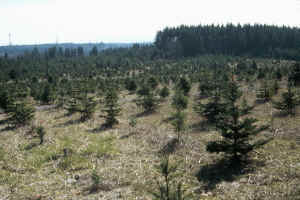 Other Classifications and Key References. Quigley and Arbelbide 181
referred to this as agricultural and exotic forbs-annual grasses cover types.
Csuti et al. 58 referred to this habitat as agricultural. The Oregon
Gap II Project 126 and Oregon Vegetation Landscape-Level Cover Type
127 that would represent this type is agriculture. U.S. Department of
Agriculture Conservation Reserve Program lands are included in this habitat. Other Classifications and Key References. Quigley and Arbelbide 181
referred to this as agricultural and exotic forbs-annual grasses cover types.
Csuti et al. 58 referred to this habitat as agricultural. The Oregon
Gap II Project 126 and Oregon Vegetation Landscape-Level Cover Type
127 that would represent this type is agriculture. U.S. Department of
Agriculture Conservation Reserve Program lands are included in this habitat.
Natural Disturbance Regime. Natural fires are almost totally suppressed
in this habitat, except for unimproved pastures and modified grasslands, where fire-return intervals can
resemble those of native grassland habitats. Fires are generally less frequent
today than in the past, primarily because of fire suppression, construction of
roads, and conversion of grass and forests to cropland 159.
Bottomland areas along streams and rivers are subject to periodic floods, which
may remove or deposit large amounts of soil.
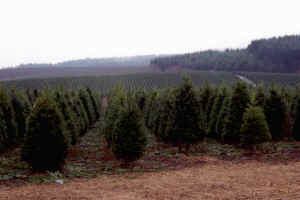 Succession and Stand Dynamics. Management practices disrupt natural
succession and stand dynamics in most of the agricultural habitats. Abandoned
eastside agricultural habitats may convert to other habitats, mostly grassland
and shrub habitats from the surrounding native habitats. Some agricultural
habitats that occur on highly erodible soils, especially east of the Cascades,
have been enrolled in the U.S. Department of Agriculture Conservation Reserve
Program. In the absence of fire or mowing, westside unimproved pastures have
increasing amounts of hawthorn, snowberry, rose (Rosa spp.), Himalaya
blackberry, spirea, Scot’s broom, and poison oak. Douglas-fir or other trees
can be primary invaders in some environments. Succession and Stand Dynamics. Management practices disrupt natural
succession and stand dynamics in most of the agricultural habitats. Abandoned
eastside agricultural habitats may convert to other habitats, mostly grassland
and shrub habitats from the surrounding native habitats. Some agricultural
habitats that occur on highly erodible soils, especially east of the Cascades,
have been enrolled in the U.S. Department of Agriculture Conservation Reserve
Program. In the absence of fire or mowing, westside unimproved pastures have
increasing amounts of hawthorn, snowberry, rose (Rosa spp.), Himalaya
blackberry, spirea, Scot’s broom, and poison oak. Douglas-fir or other trees
can be primary invaders in some environments.
Effects of Management and Anthropogenic Impacts. The dominant
characteristic of agricultural habitat is a regular pattern of management and
vegetation disturbance. With the exception of the unimproved pasture cover type,
most areas classified as agricultural habitat receive regular inputs of
fertilizer and pesticides and have some form of vegetation harvest and
manipulation. Management practices in cultivated cropland include different
tillage systems, resulting in vegetation residues during the non-growing season
that range from bare soil to 100% litter. Cultivation of some crops, especially
in the arid eastern portions of both states, may require the land to remain
fallow for 1-2 growing seasons in order to store sufficient soil moisture to
grow another crop. Harvest in cultivated cropland, Christmas tree plantations,
and nurseries, and mowing or haying in improved pasture cover types
substantially change the structure of vegetation. Harvest in orchards and
vineyards is typically less intrusive, but these crops as well as Christmas
trees and some ornamental nurseries are regularly pruned. Improved pastures are
often grazed after haying or during the nongrowing season. Livestock grazing is
the dominant use of unimproved pastures. All of these practices prevent
agricultural areas from reverting to native vegetation. Excessive grazing in
unimproved pastures may increase the prevalence of weedy or exotic species.
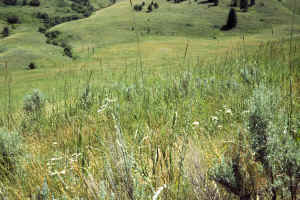 Status and Trends. Agricultural habitat has steadily increased in amount
and size in both states since Eurasian settlement of the region. Conversion to
agricultural habitat threatens several native habitat types 166. The
greatest conversion of native habitats to agricultural production occurred
between 1950 and 1985, primarily as a function of U.S. agricultural policy 96.
Since the 1985 Farm Bill and the economic downturn of the early to mid 1980's,
the amount of land in agricultural habitat has stabilized and begun to decline 164.
The 1985 and subsequent Farm Bills contained conservation provisions encouraging
farmers to convert agricultural land to native habitats 96, 153.
Clean farming practices and single-product farms have become prevalent since the
1960's, resulting in larger farms and widespread removal of fencerows, field
borders, roadsides, and shelterbelts 96, 153, 164. In Oregon,
land-use planning laws prevent or slow urban encroachment and subdivisions into
areas zoned as agriculture. Washington’s growth management is currently
controlled by counties and agricultural land conversion to urban development is
much less regulated. Status and Trends. Agricultural habitat has steadily increased in amount
and size in both states since Eurasian settlement of the region. Conversion to
agricultural habitat threatens several native habitat types 166. The
greatest conversion of native habitats to agricultural production occurred
between 1950 and 1985, primarily as a function of U.S. agricultural policy 96.
Since the 1985 Farm Bill and the economic downturn of the early to mid 1980's,
the amount of land in agricultural habitat has stabilized and begun to decline 164.
The 1985 and subsequent Farm Bills contained conservation provisions encouraging
farmers to convert agricultural land to native habitats 96, 153.
Clean farming practices and single-product farms have become prevalent since the
1960's, resulting in larger farms and widespread removal of fencerows, field
borders, roadsides, and shelterbelts 96, 153, 164. In Oregon,
land-use planning laws prevent or slow urban encroachment and subdivisions into
areas zoned as agriculture. Washington’s growth management is currently
controlled by counties and agricultural land conversion to urban development is
much less regulated.
[ Top ]
[ Literature Citations ]
[ Wildlife-Habitat Types - Table 1 ]
|